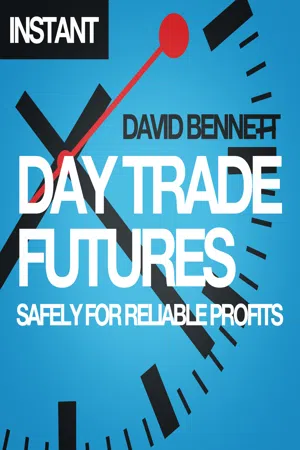
Day Trade Futures Safely For Reliable Profits
How to Use Smart Software to Develop Profitable Strategies and Automate Your Trading
- 35 pages
- English
- ePUB (mobile friendly)
- Available on iOS & Android
Day Trade Futures Safely For Reliable Profits
How to Use Smart Software to Develop Profitable Strategies and Automate Your Trading
About this book
David Bennett is a system trader, day trading futures contracts. In 'Day Trade Futures Safely For Reliable Profits' he describes his specific trading approach. He explains how he personally researches strategies, builds a trading plan, and submits trades. By learning about the way one successful trader operates, you will gain an insight into how you can refine your own trading approach.Central to the approach outlined here are two pieces of computer trading software: a tool that automates the trading process and a simulator that assists in the discovery of profitable trading strategies.If you are interested in finding out more about how computer programs can be put to use by system traders, or about how a structured system can improve your day trading, 'Day Trade Futures Safely For Reliable Profits' is for you!
Frequently asked questions
- Essential is ideal for learners and professionals who enjoy exploring a wide range of subjects. Access the Essential Library with 800,000+ trusted titles and best-sellers across business, personal growth, and the humanities. Includes unlimited reading time and Standard Read Aloud voice.
- Complete: Perfect for advanced learners and researchers needing full, unrestricted access. Unlock 1.4M+ books across hundreds of subjects, including academic and specialized titles. The Complete Plan also includes advanced features like Premium Read Aloud and Research Assistant.
Please note we cannot support devices running on iOS 13 and Android 7 or earlier. Learn more about using the app.
Information
Chapter One: The Way I Trade
Different traders, different approaches
Why futures?
Why day trade?
Automation to defeat addiction
Chapter Two: Planning
Shortcut to penury
What’s in a plan?
- When should a trade by opened? I need a trigger that tells me when to enter the market. If and when I see this trigger, I act.
- How large should the trade be? I need to know how many contracts to trade. This is the key risk and money management decision. If my position is too big, I am overexposed to risk. If it is too small, I am not taking full advantage of the opportunity.
- Where should the initial stop be placed? I never trade without a physical stop loss order in the market. Period. Stops are not perfect, but they are my best protection against disaster. The plan must tell me exactly where the stop is to be placed.
- How will I close the trade? Before getting in I must know where I will get out. It’s easy if my initial stop takes me out of the trade and it ends as a loser, but, oddly enough, it’s harder with a winner. Will I set a target, trail stops, or both? Traders beat themselves up over winners all the time. Why didn’t I hang on? Why didn’t I get out while I could? How could I have let that win turn into a loss? Don’t beat yourself up, don’t agonise; have a plan and trade that plan.
Guiding principles
- Don’t overtrade. Seek high quality trades, and keep out of the market if the entry trigger doesn’t appear during a session. My personal rule is to take at most one trade each day (in any particular market). Leverage on futures trading is such that just one or two trades can yield an excellent monthly return, so why look for more? I need to be honest with myself – am I looking for profits, or am I looking for action? If I am addicted to action, I am not a serious day trader.
- Keep it simple. I know I have truly understood a complex idea if I can express it in a simple, clear, concise form. I work hard to eliminate unnecessary complexity from my plans.
- Stick to the plan. I may as well not have a plan if I don’t adhere to it. It is much easier to stick to a simple plan than a complex one, which is one reason why simplicity must be an overriding goal.
- Eliminate errors. Just one implementation error can totally destroy a trading month. Errors are hard to eliminate because trading is stressful and fast moving. This is one of the great advantages of automation. A computer doesn’t get tired, impatient or flustered, regardless of market conditions. When trading manually, a simple system is much less error prone than a complex one; another reason to strive for simplicity.
- Understand the rationale. Plans should be based on a sound trading idea. In my case, I look for entries based on intraday support and resistance levels and how I believe the market reacts to them. Other traders may use different stimuli. The point is your trade should be based logically on the assumptions you make about market action in certain situations; I never enter a trade if it is not in accordance with one of my theories of market action. For example, I might look at the market over the last three years and notice that a particular strategy would ...
Table of contents
- Cover
- Publishing details
- Preface
- Chapter One: The Way I Trade
- Chapter Two: Planning
- Chapter Three: Trading Style
- Chapter Four: Details of the Trading Plan
- Chapter Five: Researching Optimal Strategy Settings
- Chapter Six: Traps for Unwary Traders
- Chapter Seven: Last thoughts
- Good Luck!